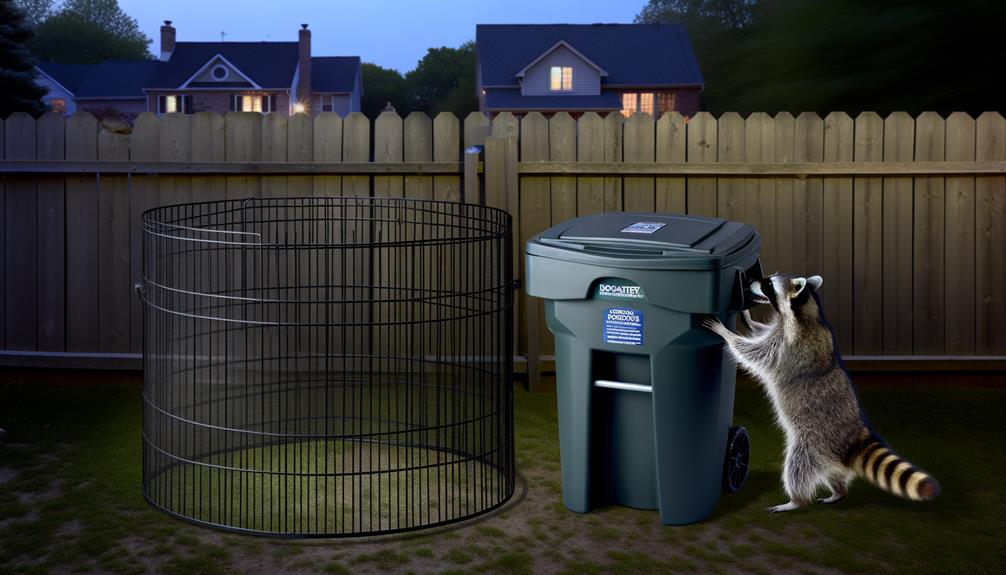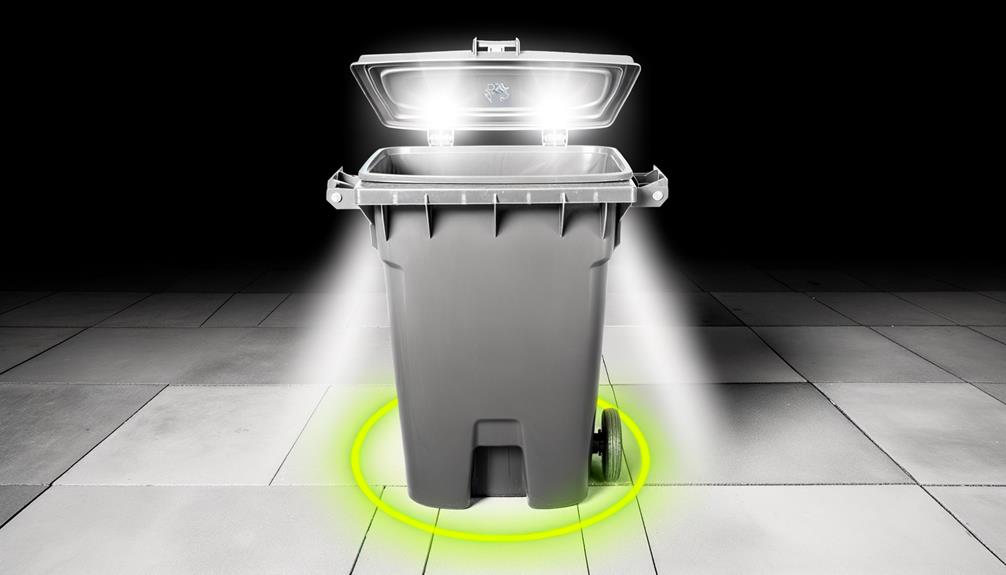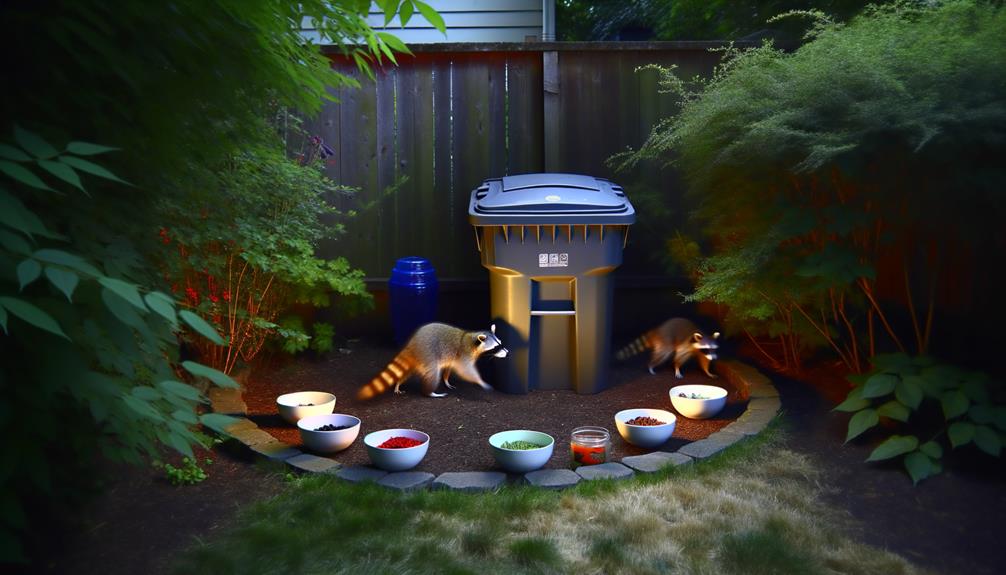How Do I Stop Raccoons from Eating My Garbage?
To stop raccoons from accessing your garbage, start by securing trash can lids with tightly fitting mechanisms or heavy-duty straps. Utilize raccoon-proof containers, such as those with lid locking systems and constructed from high-density polyethylene or steel.
Eliminate food sources by securing compost bins, removing pet food, and cleaning barbecue grills. Installing motion-activated LED lights can also deter raccoons through sudden illumination.
Additionally, natural repellents like peppermint oil, cayenne pepper, and ammonia can serve as effective deterrents. For a thorough array of solutions, explore the listed strategies further.

Key Takeaways
- Ensure lids are tightly fitting and use bungee cords or heavy-duty straps to secure trash cans.
- Invest in raccoon-proof containers with locking mechanisms like the Toter Bear-Tight or Simplehuman Locking Can.
- Eliminate food sources by securing compost bins, removing pet food, and cleaning barbecue grills.
- Install motion-activated lights with infrared sensors near entry points to deter raccoons.
- Apply natural repellents like peppermint oil, cayenne pepper, or ammonia around trash areas to keep raccoons away.
Secure Your Trash Cans

Securing your trash cans is the most effective method to prevent raccoons from accessing and scattering your waste. Raccoons are intelligent and dexterous creatures, capable of manipulating unsecured lids and containers.
To lessen this, make sure all trash cans have tightly fitting lids that are challenging for raccoons to dislodge. Use bungee cords or heavy-duty straps to further secure the lids, thereby inhibiting easy access.
Placing trash cans in well-lit areas can also deter raccoons, as they prefer to operate under the cover of darkness. Additionally, avoid overfilling your trash cans to ensure the lids can close completely.
These measures collectively create a strong barrier, notably reducing the likelihood of raccoon interference with your waste disposal.
Use Raccoon-Proof Containers
Investing in raccoon-proof containers is a critical step in safeguarding your waste from these persistent scavengers. These specialized containers are designed with secure locking mechanisms and robust materials that prevent raccoons from accessing their contents. Selecting the right container involves understanding different features and specifications that enhance their effectiveness. Below is a comparative analysis of key attributes of various raccoon-proof containers available in the market:
| Feature | Description | Example Products |
|---|---|---|
| Lid Locking Mechanism | Secure, tamper-proof locks | Toter Bear-Tight, Simplehuman Locking Can |
| Material | Durable, heavy-duty construction | Steel, high-density polyethylene |
| Capacity | Varies according to household needs | 32-gallon, 64-gallon, 96-gallon |
| Ease of Use | User-friendly design for convenient access | Step-on, automatic locking systems |
| Cost | Price range based on features | $50 – $200 |
Utilizing these containers effectively mitigates the risk of raccoon incursions.
Eliminate Food Sources

Reducing available food sources is essential to preventing raccoons from targeting your property. Raccoons are opportunistic feeders, and eliminating potential attractants will greatly reduce their visits.
Follow these steps to minimize food accessibility:
- Secure Compost Bins: Ensure compost bins are tightly sealed and not emitting food aromas. Utilize raccoon-resistant models if available.
- Remove Pet Food: Avoid leaving pet food outdoors overnight. Feed pets indoors or promptly remove any uneaten food.
- Clean Barbecue Grills: After use, thoroughly clean grills and remove any food residue. Store grills in a secure location if possible.
Install Motion-Activated Lights
Implementing motion-triggered lights can serve as an effective deterrent to prevent raccoons from approaching your property during nighttime hours. These devices utilize infrared sensors to detect movement, subsequently activating a bright light that startles and discourages nocturnal wildlife from lingering.
Installation is straightforward: place the lights near garbage containers and other potential entry points. Opt for units with sensitivity adjustments to fine-tune detection parameters, reducing false triggers from non-threatening movements. For best results, choose LED lights due to their longevity and energy efficiency.
Additionally, make sure the lights are weatherproof to withstand outdoor conditions. This strategic lighting solution not only deters raccoons but also enhances overall property security, providing a dual benefit of wildlife control and safety enhancement.
Apply Natural Repellents

Utilizing natural repellents can effectively discourage raccoons from rummaging through your garbage, leveraging their aversion to certain scents. Employing such methods is not only eco-friendly but also a humane approach to deterring these nocturnal intruders.
Here are three potent natural repellents:
- Peppermint Oil: Raccoons find the strong scent of peppermint overwhelming. Soak cotton balls in peppermint oil and place them around your garbage bins.
- Cayenne Pepper: Sprinkle cayenne pepper around the trash area. Its pungent odor and spicy nature deter raccoons from approaching.
- Ammonia: Soak rags in ammonia and place them near the garbage. The strong, acrid smell is highly repellent to raccoons.
Implementing these strategies can help maintain a raccoon-free environment.
Conclusion
To sum up, safeguarding trash from raccoons necessitates a multifaceted approach:
- Securing trash cans
- Utilizing raccoon-proof containers
- Eliminating accessible food sources
- Installing motion-activated lights
- Applying natural repellents
Each method serves as a layer of defense, collectively forming an impenetrable fortress against these nocturnal invaders. By systematically implementing these strategies, the likelihood of raccoon interference can be markedly reduced, thereby maintaining cleanliness and preventing potential health hazards associated with scavenging wildlife.






